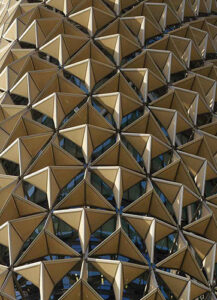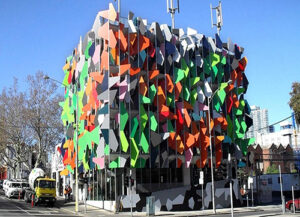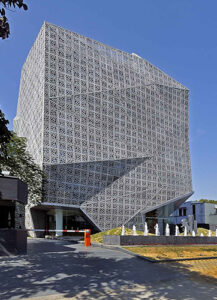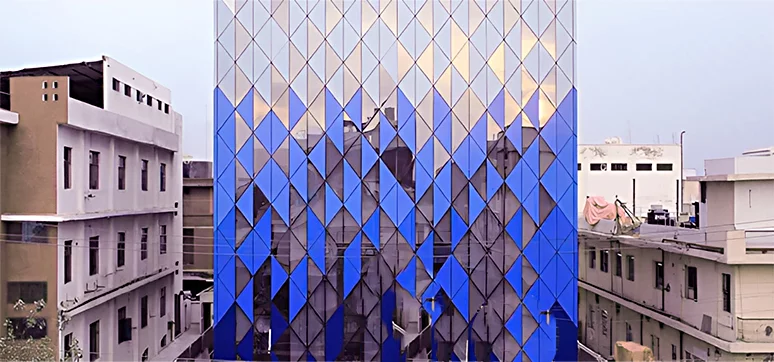“We” shape our buildings thereafter they shape us”, Winston Churchill Restoration of the façade of an ageing building that is still strong enough to last a few more decades, will give it a new identity and breathe fresh life into it. A building can get old, or its design may become obsolete, as architecture is evolving constantly with new ideas and new technologies. Over the years, there can be leaks due to damaged silicone joints and glazing gaskets, worn-out cladding systems or rusted support systems, and building maintenance can become more expensive due to rising replacement and operating costs and decreased energy efficiency of outdated façade systems. The same can be said for older glazing that may have glass without high-performance low-e coatings. This may be sufficient for building owners to consider options for façade replacement.
There is also the pressure to attract new tenants or to increase rent through the modernisation of an antiquated-looking exterior. Few significant buildings become a representation of their time. Such heritage architecture is about the conservation of the traditional architectural style, which has to be maintained the way the building was originally built and may involve restoration of the elements that have been destroyed or damaged by time.
Retrospective Façade – Multifunctional Energy Efficient Façade System For Building Retrofitting

Sometimes, relatively new structures that no longer appeal to the occupants, or buildings that have to undergo a functional change, may need uplift. In both cases, we have to design a new façade for the building and retrofit it over the old structure, giving it a brand-new look, and improving its energy efficiency. With the current spate of fire in buildings, it becomes all the more important to diligently review systems, using fire-proof and fire-retardant technology.
Improving energy consumption in the existing building will require the retrofitting of many, if not most, of these façades. While many buildings are currently undergoing energy retrofits, the scope of the renovation often stops short of the façade because of the relatively high cost and the potential disruption to ongoing building operations. Even when the façade is included in an energy retrofit program, the options for approaching the façade element are often not prioritised.
High-Performance Façade: Need Of Every Building Aspiring To Be Energy Efficient
Energy performance review as an approach helps, both in terms of helping the environment and being able to save on energy costs. By having a proper façade system, we can benefit from their natural thermal properties, which will create a layer of insulation. This insulation layer prevents the hot air from infiltrating into the building and helps maintain an optimal indoor climate.
By intertwining all of the different variables and factors, we will be able to have an end product that will be aesthetically pleasing which will yield results that are efficient in terms of energy, comfort & acoustics and are coordinated with one another. These unique solutions from suppliers, manufacturers and installers must be tailor-made for office spaces that cannot afford to lose working hours for a retrofitting solution.
The Retrofit Opportunity
Today, the problem of poor-performing, ageing glass curtain walls is now an opportunity to combine needs with solutions in a façade retrofit. Sustainable building practice values the reuse of these ageing buildings as a superior strategy to demolition, recycling and rebuilding. Retrofitting is also a well-known sustainable model of reuse. There is no question that many buildings of this type could benefit significantly from a façade retrofit, and there is equally no doubt that recent material developments and technology can significantly improve their performance and likely their appearance.
Emerging Ideas: A Multifunctional Energy Efficient Façade System For Building Retrofitting

The concept idea is based on efficiency and on a multi-functional integrated system. It can develop an innovative concept for retrofitting that applies multi-functional energy-efficient panel modules, as well as innovative composite façade structure materials, all easily integrated into the façade for building envelope retrofitting. This new façade system can be easily adapted to fit climatic conditions and any type of building façade, making it highly flexible in terms of use and deployment. This has the potential to improve the energy efficiency of buildings all over the world.
This provides a golden opportunity for research teams to work collaboratively on the development (architectural, energetic, installation, material), evaluation (of energy efficiency, material fire resistance) and demonstration (in the real-life building) of the façade system. Such a project can bring together a multidisciplinary consortium with a well-balanced distribution between industry and research organisations. The team can be composed of large companies, technologically specialised SMEs, research as well and open innovation organisations.
Demonstration Plans
The multifunctional energy efficient façade system solution can be demonstrated in a real building located in a region with diurnal variation and/or high seasonal temperature variations are common. The range in climatic conditions ensures that the system is tested in different conditions. The building will be monitored before and after the installation of the new retrofitting system to evaluate the performance of the solutions.
The objectives shall be:

- To demonstrate the system, including the structural panel and (some of) the technological modules in a real building retrofitting scenario
- To identify the limitations and problems of the whole system and the technological units installed in the pilot building and to optimise their performance
- To assess the performance of the integrated system
- To certify the retrofitted building according to current national standards
- To validate the on-site cost advantages of the new system
- To validate the façade configuration and general conditions to be suitable for at least two other European climates
Market For Building Retrofitting
The market for retrofitting has been growing steadily over the past couple of years, although this has not been happening at the same rate and speed globally. According to a report from Pike Research, this global market will expand to $151.8 billion by 2020.
Retrofitting is identified as one of the most cost-effective ways to reduce operational costs. A variety of financial instruments are required to support the process of energy efficiency retrofitting which will enable the market to grow. Western Europe is identified as the biggest market of retrofits for energy efficiency. Asia and the US will increase to $54.6 billion and $35.3 billion respectively by 2020.
Market Barriers To Building Retrofitting
Market barriers must also be taken into account when addressing the deployment and uptake of retrofitting practices. Uncertainty in the market is a key barrier to building retrofitting. As is the case, consistency in the support offered as well as guarantees that the support will not be abruptly interrupted would enable stakeholders to have confidence in their investments and support received over time, thus continuously supporting the successful emergence of the market.
A report identifies market barriers that can give rise to “latent risks”. These are the types of risks that can emerge in case the demand for building retrofitting increases and these risks are not accounted for. Overall, the ability of markets to respond to these changes and the Demonstration model to mitigate risks is once again related to confidence in the markets and appropriate signals that are given in consistent ways and with a long-term vision.

Not all building owners will find it economically viable to renovate their properties. To deliver the renovation targets, the Government should not only frame regulatory policies to provide standards and encourage energy performance certification, but also to coerce some actions from stakeholders
The main stakeholders in retrofitting projects are building owners, the occupants, energy utility companies and other financing bodies, retrofit providers and Governments. For a business model to work, each of these stakeholders’ interests must be considered, and address all the barriers listed in the previous sections.
It has also been reported that overall the market for energy-efficient building retrofitting is shifting away from one-time retrofits to models where upgrades are continuous and the use of ICT and real-time monitoring enables these projects to be implemented in a smarter way, thus successfully reaching the expected (simulated) cost savings and emission reductions.
The Beginning
Façade retrofit thus represents a unique process, significantly different from that of new construction. Façade retrofit has a tremendous looming need of some importance. It is critical that this retrofit work be carried out efficiently and effectively. Yet this remains largely undefined territory. Everything from contracting strategies to system designs and means-methods considerations involves considerable ambiguity, and sustainability issues are problematic in the extreme.
The following are the primary conclusions derived from this exercise:
-

72 Screens, Jaipur There is an urgent need to define appropriate retrofit strategies, evaluation criteria for their application, and the definition of means and methods for the implementation of the various strategies, possibly taking the form of best practice guidelines for the various stakeholders.
- Design practices for new façades that anticipate and accommodate the eventual need for retrofit could facilitate future retrofit requirements. Façade systems should be designed to facilitate the retrofitting of new materials and technology as developments occur.
- Sustainable façade retrofit practices must be developed; a focus on material reuse is imperative to avoid filling landfills with discarded façade materials, particularly glass.
- New architectural glass recycling (not down-cycling) technologies are needed.
- Advanced façade solutions using raw float glass should be pursued because of the uncompromised material life and the potential for easy recycling. Doubleskin strategies may accommodate this in certain applications.
- Costing models that factor in the environmental cost of damaging construction practices and the true cost of energy are urgently needed to correct inaccurate perceptions of long payback periods for energy-efficient technology.
- Additional mandatory measures regarding building energy and carbon performance will be required in the private commercial sector to achieve appropriate goals for energy use in existing buildings within this sector.
The impact of building façades on urban spaces is inevitable. It should be noted that being in a beautiful space, not only will have a favourable impact on improving the quality of life but also prevent the emergence of adverse social interactions and develop optimal interactions. The best outcome of retrofits depends on intricate skills and procedures. Complexity in façade and variation in the façade system requires a team displaying high-quality experience and a defined approach. Most importantly, the owner/developer needs to share all relevant building information and necessary support from site staff and contractors, thus formulating a Synergy.

Colliers International
Co-Author:
Rahul Arangannal is a Senior Manager with over 12 years of experience in construction project management. Arangannal has managed all aspects of project management in various projects across Bengaluru and India.
References:
[1] Tri Tessellated Office Building in India by Akda
[2] AL BAHR TOWERS – AHR Global
[3] Pixel Building Australia – PSU Edu
[4] Meefs Retrofitting – Demonstration
[5] Meefs Retrofitting – Facade Concept Project
[6] AEC Cafe – Screens in Jaipur by Sanjay Puri Architects














